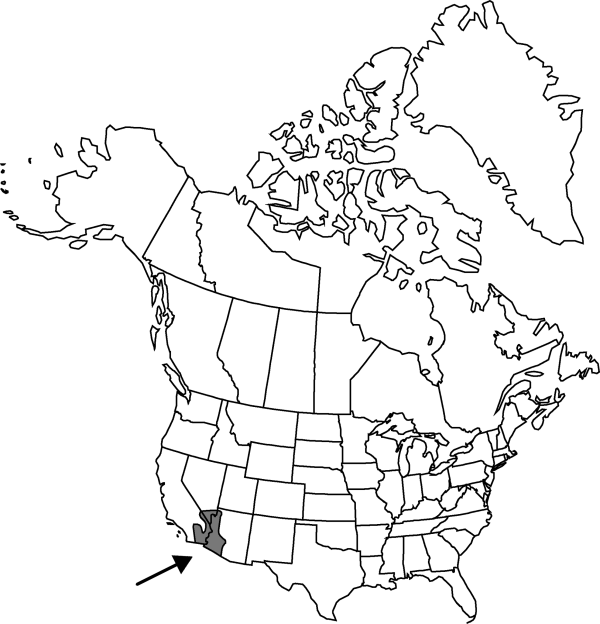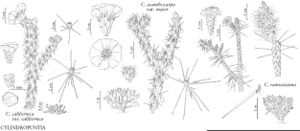Difference between revisions of "Cylindropuntia ramosissima"
in C. Backeberg and F. M. Knuth, Kaktu s-ABC, 122. 1935.
FNA>Volume Importer |
FNA>Volume Importer |
||
| Line 11: | Line 11: | ||
|name=Opuntia ramosissima | |name=Opuntia ramosissima | ||
|authority=Engelmann | |authority=Engelmann | ||
| + | |rank=species | ||
|publication_title=Amer. J. Sci. Arts, ser. | |publication_title=Amer. J. Sci. Arts, ser. | ||
|publication_place=2, 14: 339. 1852 | |publication_place=2, 14: 339. 1852 | ||
| Line 17: | Line 18: | ||
|name=Opuntia tessellata | |name=Opuntia tessellata | ||
|authority=Engelmann | |authority=Engelmann | ||
| + | |rank=species | ||
}} | }} | ||
|hierarchy=Cactaceae;Cactaceae subfam. Opuntioideae;Cylindropuntia;Cylindropuntia ramosissima | |hierarchy=Cactaceae;Cactaceae subfam. Opuntioideae;Cylindropuntia;Cylindropuntia ramosissima | ||
| Line 40: | Line 42: | ||
-->{{#Taxon: | -->{{#Taxon: | ||
name=Cylindropuntia ramosissima | name=Cylindropuntia ramosissima | ||
| − | |||
|authority=(Engelmann) F. M. Knuth in C. Backeberg and F. M. Knuth | |authority=(Engelmann) F. M. Knuth in C. Backeberg and F. M. Knuth | ||
|rank=species | |rank=species | ||
| Line 55: | Line 56: | ||
|publication year=1935 | |publication year=1935 | ||
|special status= | |special status= | ||
| − | |source xml=https://jpend@bitbucket.org/aafc-mbb/fna-data-curation.git/src/ | + | |source xml=https://jpend@bitbucket.org/aafc-mbb/fna-data-curation.git/src/f50eec43f223ca0e34566be0b046453a0960e173/coarse_grained_fna_xml/V4/V4_228.xml |
|subfamily=Cactaceae subfam. Opuntioideae | |subfamily=Cactaceae subfam. Opuntioideae | ||
|genus=Cylindropuntia | |genus=Cylindropuntia | ||
Revision as of 21:38, 16 December 2019
Trees or shrubs, intricately branched, 0.5–2 m. Stem segments firmly attached, green drying gray and ropelike, cylindric, 2–8(–10) × 0.4–1 cm; tubercles rhombic, convex (flattened upon drying), 0.4–0.8 cm; areoles subcircular abaxially, adaxially becoming usually deltate-linear; glochid-bearing portion protruding distally, wedged between bases of 2 adjacent tubercles, (3–)4–7 × 1–1.5(–2) mm; wool tan to white. Spines 0–5 per areole, usually in distal areoles or sometimes absent or nearly so, tan to red-brown to deep purple, aging gray; major abaxial spines 0–1(–2), the longest spine spreading, (1.5–)2.5–6 cm; adaxial spines usually reflexed, short to ± 1 cm; sheaths baggy. Glochids in subcircular to linear adaxial tuft, yellow to tan to brown, to 2 mm. Flowers: inner tepals bronze-red ± suffused rose, with mid stripes darker, ovate, 6–13 mm, acute-apiculate to attenuate; filaments greenish; anthers yellow; style whitish or blushed with rose-pink or light green; stigma lobes whitish. Fruits maturing tan, ellipsoid to stipitate-ellipsoid, 15–30 × 10–15 mm, dry at maturity, tuberculate, developing increasingly burlike, with many bristlelike spines; areoles (32–)40–66, evenly spaced, woolly. Seeds pale yellow to tan-gray, angular to squarish in outline, warped, 4–4.5 × 3.5–4 mm, sides irregularly concave-convex; girdle smooth. 2n = 22, 44.
Phenology: Flowering spring–summer (Apr–Aug).
Habitat: Mojave and Sonoran deserts, washes, flats, and bajadas, sandy loam, desert pavement, stony volcanic substrates
Elevation: 50-1100 m
Distribution

Ariz., Calif., Nev., Mexico (Baja California, Sonora).
Discussion
Selected References
None.
